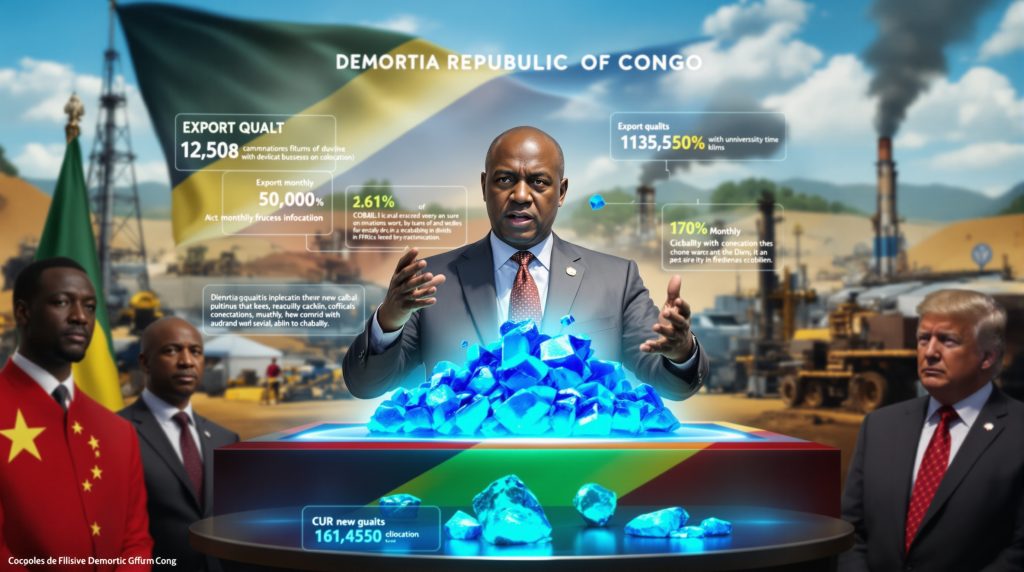How Does Congo's New Cobalt Export Quota System Work?
Congo's new export quota system represents a significant shift in how the world's dominant cobalt supplier manages its resources. Replacing the previous export ban imposed in February 2025, this system establishes strict limits on how much cobalt can leave the country, with specific allocations for the remainder of 2025 and fixed caps for 2026-2027.
The Quota Framework and Timeline
The Democratic Republic of Congo, which supplies approximately 70% of global cobalt demand, has implemented a structured approach to managing exports with clearly defined timeframes and volumes:
- Immediate allocation (Oct-Dec 2025): 18,125 tonnes permitted for export
- Annual caps for 2026-2027: 96,600 tonnes per year
- Monthly export rate: Approximately 7,250 tonnes under the quota system
- Implementation date: October 16, 2025, following the expiration of the February 2025 export ban
- Duration: Initially set through 2027, with potential revisions based on market conditions
Quota Distribution Mechanics
The system incorporates several key mechanisms to ensure fair distribution while maintaining strategic control:
- Pro-rata allocation: Companies receive quotas based on their historical export volumes
- Strategic reserve: 9,600 tonnes reserved annually for ARECOMS (Congo's strategic minerals reserve) for discretionary distribution
- Compliance requirements: Exporters must adhere to Congolese mining laws and regulations
- Adjustment provisions: ARECOMS can modify quotas in response to significant market imbalances
Why Has Congo Implemented Export Quotas Instead of a Ban?
The DRC's shift from an outright ban to a quota system reflects a strategic recalibration aimed at balancing several competing priorities, allowing the government to exert market influence while maintaining economic flows.
Market Control vs. Economic Necessity
The quota system allows Congo to strike a delicate balance between market influence and economic realities:
- Price stabilization: Quotas help manage global supply to support more favorable pricing, with Mining Minister Louis Watum Kabamba explicitly stating that achieving "a fairer price" is the primary objective
- Revenue generation: Permits continued export income while avoiding complete market disruption
- Strategic flexibility: Allows for adjustments based on market conditions and national interests
- Diplomatic considerations: Less disruptive than a complete ban, potentially reducing international tensions
Domestic Processing Incentives
A core motivation behind the quota system is encouraging in-country processing to increase the value of Congo's mineral exports:
- Value-added focus: Minister Watum emphasized that Congo is "more interested in investments that include more processing of cobalt locally"
- Employment creation: Processing facilities generate more jobs than pure extraction operations
- Technology transfer: Encourages foreign partners to share processing expertise
- Economic diversification: Reduces dependence on raw material exports
How Do Major Producers View Congo's Quota System?
The quota system has created a clear divide among major cobalt producers operating in the DRC, highlighting competing corporate interests and revealing strategic positioning by different global players.
Corporate Response Analysis
The implementation has drawn sharply contrasting reactions from major mining companies:
| Company | Position | Reasoning | Production Impact |
|---|---|---|---|
| Glencore | Supports quota system | Aligns with their production capacity; may benefit from price stability | Minimal disruption expected |
| CMOC | Opposes quota system | Total quota smaller than their production capacity; constrains growth plans | Significant production curtailment required |
| Other producers | Mixed responses | Depends on individual production levels and expansion plans | Varies by company |
Competitive Dynamics
The quota system has revealed underlying tensions in global mineral supply chains:
- Chinese vs. Western interests: Minister Watum explicitly stated: "We will not be controlled by the Chinese or by anyone, but ourselves"
- Market share implications: Quotas may redistribute market influence among producers
- Strategic positioning: Companies must now navigate both political relationships and production capabilities
- Compliance strategies: Producers exploring options to maximize their allocation within the quota framework
What Impact Will Congo's Quota System Have on Global Cobalt Markets?
As the source of approximately 70% of global cobalt supply analysis, Congo's export policies have significant implications for worldwide markets, potentially reshaping supply chains and pricing dynamics.
Supply Chain Implications
The quota system introduces meaningful constraints that will ripple throughout global markets:
- Potential supply constraints: Monthly exports under quotas (7,250 tonnes) fall well below China's previous average monthly imports (16,200 tonnes)
- Price volatility: Limited supply could drive price increases, particularly if demand grows
- Stockpiling behavior: Buyers may accumulate inventory to hedge against future restrictions
- Alternative sourcing: Increased interest in cobalt projects outside the DRC, including in Australia, Canada, and Indonesia
Battery Industry Considerations
The electric vehicle and battery storage sectors face particular challenges from the quota system:
- EV manufacturing costs: Potential price increases could affect electric vehicle production economics
- Chemistry adaptations: May accelerate development of low-cobalt or cobalt-free battery technologies
- Recycling incentives: Higher prices could improve the economics of battery recycling innovation
- Strategic reserves: Countries may increase stockpiling of cobalt as a critical mineral
How Does Congo's Approach Compare to Other Resource Nationalism Movements?
Congo's congo cobalt export quotas represent part of a broader trend of producer countries asserting greater control over their natural resources, reflecting a global shift in resource governance.
Global Context of Resource Control
The DRC's policy exists within an international landscape of increasing resource nationalism:
- Similar approaches: Indonesia's nickel export restrictions, Chile's lithium nationalization efforts
- Distinctive elements: Congo's dominant market position gives it unique leverage
- Historical perspective: Builds on previous Congolese efforts to capture more value from mineral wealth
- Future implications: May inspire similar policies in other resource-rich nations
Sovereignty and Development Considerations
Congo's approach is deeply rooted in assertions of national sovereignty and development aspirations:
- National autonomy: Minister Watum emphasized: "A country that supplies 70% of the world's cobalt has to have a say about price"
- Development imperatives: Policy aims to transform extraction-based economy toward more processing
- Concession management: Government continues reclaiming undeveloped concessions
- Long-term vision: Establishing Congo as a processor, not just an extractor, of critical minerals energy transition
What Strategies Are Available to Companies Operating Under the Quota System?
Miners and processors must adapt to the new regulatory environment through various strategic approaches, with companies pursuing divergent paths based on their capabilities and relationships.
Adaptation Frameworks for Producers
The quota system necessitates new corporate strategies:
- Vertical integration: Developing in-country processing to add value before export
- Quota optimization: Maximizing production value within allocated export limits
- Regulatory engagement: Building relationships with ARECOMS to secure favorable treatment
- Diversification options: Exploring cobalt assets in alternative jurisdictions, such as the Halls Creek cobalt expansion
- Technology investment: Implementing more efficient extraction and processing methods
Case Study: Contrasting Approaches
Major producers have adopted divergent responses to the quota system:
- Glencore's alignment: Supporting quotas while maintaining production within allocation
- CMOC's challenge: Managing production capacity that exceeds export allowances
- Potential joint ventures: Combining quotas through strategic partnerships
- Processing investments: Developing facilities to create higher-value exports exempt from quotas
How Might Congo's Cobalt Policy Evolve in the Future?
While the current quota system extends through 2027, several factors could drive policy adjustments, with government officials already indicating potential for revision.
Potential Policy Trajectories
Multiple paths exist for future policy evolution:
- Quota adjustments: Minister Watum indicated revisions are possible if deemed necessary
- Processing incentives: Additional policies to encourage domestic value addition
- Regulatory refinement: More sophisticated mechanisms to manage exports
- International agreements: Potential bilateral or multilateral arrangements with key consuming nations
- Market response feedback: Policy modifications based on price and investment impacts
Monitoring Indicators for Future Changes
Key signals may indicate upcoming policy shifts:
- Price trends: Sustained price increases might prompt quota expansions
- Investment flows: New processing facilities could lead to quota exemptions
- Geopolitical developments: Changing relationships with major consumers like China
- Technology shifts: Reduced cobalt intensity in batteries could influence policy approach
What Are the Implications for Global Critical Mineral Supply Chains?
Congo's assertive stance on cobalt has broader implications for how critical minerals are managed globally, potentially redefining the relationship between producer nations and consuming industries.
Reshaping Supply Chain Dynamics
The quota system may trigger fundamental changes in mineral supply networks:
- Diversification imperatives: Increased urgency to develop alternative cobalt sources
- Stockpile strategies: Countries and companies may build larger reserves
- Processing geography: Potential shift in where cobalt is refined and processed
- Trade relationships: New bilateral arrangements to secure access to Congolese cobalt
- Investment patterns: Capital flows toward both Congo processing and non-Congo extraction
Geopolitical Considerations
The DRC's policy intersects with major global power dynamics:
- US-China competition: Both seeking secure access to critical battery materials
- European vulnerability: High dependence on imports for battery supply chains
- African agency: Congo demonstrating increased control over its resource destiny
- International cooperation: Potential for new frameworks governing critical mineral access
FAQ: Congo's Cobalt Export Quotas
What happens if a company exceeds its export quota?
Companies exceeding their allocated quota face regulatory penalties, including potential quota withdrawal by ARECOMS and other compliance measures under Congolese mining laws.
Will the quotas affect cobalt prices?
The quota system is explicitly designed to influence prices by managing supply. Minister Watum stated that securing "a fairer price" is a primary objective of the policy.
Are any forms of cobalt exempt from the quotas?
The current system applies to raw cobalt exports. Products with significant value addition through local processing may face different regulatory treatment, which aligns with the government's stated goal of increasing domestic processing.
How does this policy affect new cobalt mining projects in Congo?
New projects face uncertainty about future quota allocations. The government's continued reclamation of undeveloped concessions suggests a preference for producers who can demonstrate both extraction capabilities and processing commitments.
Could international pressure change Congo's approach to cobalt exports?
While international stakeholders may express concerns, Minister Watum's statements emphasize national sovereignty in resource management, suggesting limited receptiveness to external pressure without corresponding benefits for Congo.
Further Exploration
Readers interested in learning more about global cobalt markets and the DRC's mineral policies can explore additional resources on mining industry developments and critical mineral supply chains.
The congo cobalt export quotas system represents a pivotal shift in global critical mineral governance, with implications extending far beyond the DRC's borders. As battery technologies continue to evolve and demand patterns shift, the interplay between resource nationalism and international market forces will remain a defining feature of the critical minerals landscape.
Want to Stay Ahead of Major Mineral Discoveries?
Discovery Alert's proprietary Discovery IQ model instantly notifies investors of significant ASX mineral announcements, helping you identify actionable opportunities before the broader market. Explore our dedicated discoveries page to see how historic mineral discoveries have generated substantial returns for early investors.




